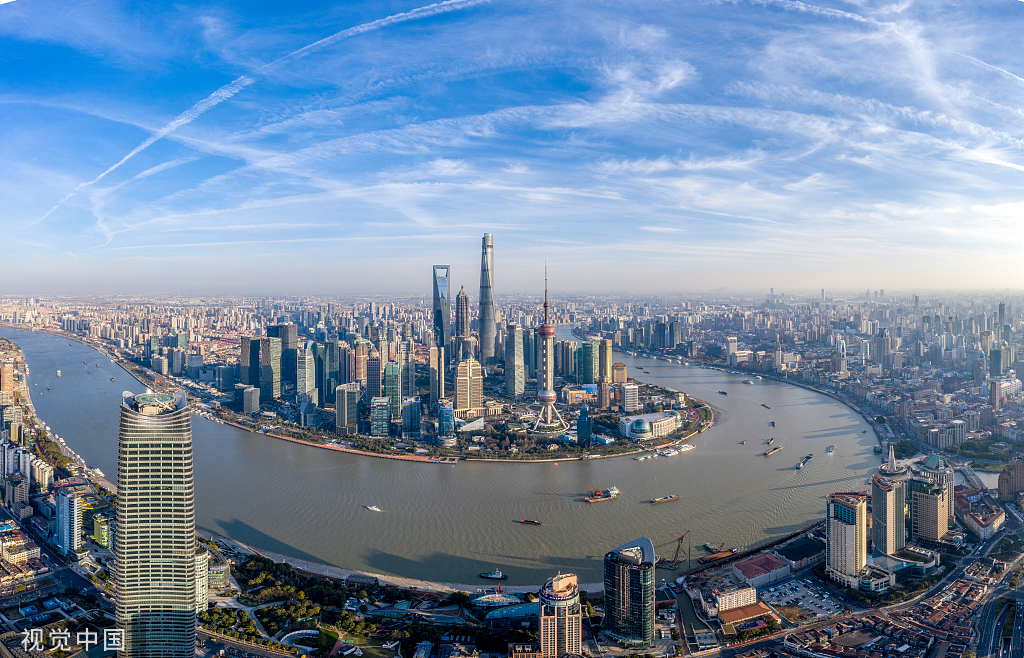Our Terms & Conditions | Our Privacy Policy
China’s ‘opening-up’ in contrast to ‘high walls’ – Opinion

A view of the Huangpu River in Shanghai. [Photo/VCG]
Anti-globalization, unilateralism and protectionism have been hindering global trade in recent years, with some countries trying to retreat behind “high walls” and insulating their economies, and some adopting “de-risking” policies, especially against China.
On the contrary, China has been advancing institutional opening-up by aligning its rules and regulations with high-standard international trade and economic regulations and intensifying domestic reforms in various sectors to create a favorable environment for emerging industries. At the same time, China is also expanding its markets for goods, services, capital and labor, and further opening up its various sectors especially for least-developed countries to deepen its economic cooperation with them.
Foreign investment remains a critical pillar of economic growth, and China has been further reforming its foreign investment system to attract more foreign capital by expanding the list of encouraged industries for foreign investment, reducing market restrictions, and lifting barriers in the manufacturing sector. It is also strengthening intellectual property rights protection and supporting key foreign-invested projects to attract more investments, particularly in high-tech industries, fostering collaboration between domestic and global entities, and creating a favorable environment for new industries and business models.
Besides, by advancing regional development strategies and strengthening inter-regional cooperation, China aims to integrate local economies into the global industry and supply chains, with the supporting policy of establishing free trade zones to promote the liberalization of trade and investment.
Through the Belt and Road Initiative, China is deepening global economic and trade cooperation with the focus on high-quality development.
China has also applied to join major agreements including the Comprehensive and Progressive Agreement for Trans-Pacific Partnership and the Digital Economy Partnership Agreement, which it views as essential for creating a more equitable global governance system.
China”s commitment is also reflected in its offer of zero-tariff treatment to all products from the least-developed countries that are its trading partners to help them integrate into the global trading system. And to further promote global cooperation, China has introduced visa-free policies for citizens of 38 countries, including Thailand and Singapore, while hosting the China International Import Expo that saw nearly $60 billion in transactions and strengthened the ties between global exhibitors and buyers.
By prioritizing green and digital trade, China is offering solutions to global challenges while transforming its own economic model. For example, China has collaborated with the European Union on energy platforms and clean energy technologies, promoting sustainable practices.
On the digital trade front, China’s “Silk Road E-commerce” spans five continents, facilitating cross-border cooperation in e-commerce. The participation of more than 80 countries and international organizations in the 2024 China International Fair for Trade in Services underscores China’s growing role in the global service trade, contributing to a more inclusive global economy.
The “Invest in China” campaign, which facilitates exchanges with foreign enterprises and business associations, is part of the country’s strategy to create a competitive, law-based environment for businesses. By granting foreign investment greater access in sectors such as healthcare and telecommunications, China aims to not only attract more investments but also foster innovation and collaboration between domestic and foreign companies.
Moreover, China has been enhancing its regional and international partnerships through free trade agreements. The 23 trade agreements China has signed with 30 countries and regions, including the upgraded China-ASEAN Free Trade Area, cover emerging fields such as the digital economy and strengthen economic ties with ASEAN. And the development of the Hainan Free Trade Port will offer new global development opportunities.
Through regional cooperation mechanisms such as APEC, China is also promoting new energy projects, including solar photovoltaic and wind energy cooperation with Latin American countries, to create mutual benefit for all parties.
Furthermore, through the Belt and Road Initiative, China is deepening global cooperation in advanced technologies, green development and digital infrastructure. By establishing agricultural technology demonstration centers, technology transfer hubs, and launching initiatives like the Belt and Road Green Development Partnership with more than 150 partners, China is laying the groundwork for sustainable development. China’s efforts to bridge the digital divide in Belt and Road countries by improving the infrastructure are helping the beneficiary countries to boost their development.
Lyu Yue is a professor at the Academy of China Open Economy Studies, University of International Business and Economics.
Chen Sida is a postdoctoral fellow at the School of International Trade and Economics, University of International Business and Economics.
The views don’t necessarily reflect those of China Daily.
If you have a specific expertise, or would like to share your thought about our stories, then send us your writings at opinion@chinadaily.com.cn, and comment@chinadaily.com.cn.
[ad_1]
Images are for reference only.Images and contents gathered automatic from google or 3rd party sources.All rights on the images and contents are with their legal original owners.
[ad_2]



Comments are closed.